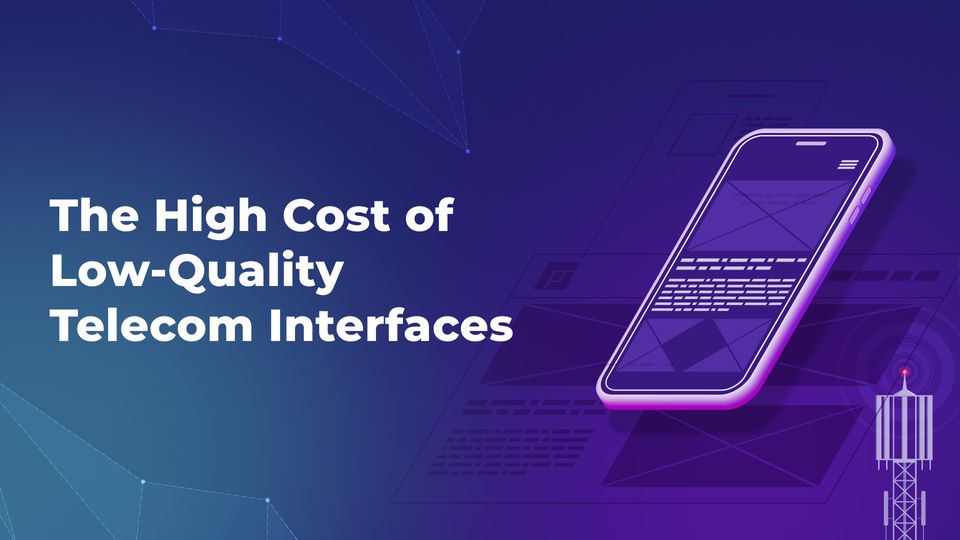The High Cost of Low-Quality Telecom Interfaces: How to Solve the Problems of Bad UX

Telecom companies are constantly on the lookout for fresh sources of revenue. They are embracing the future and investing early in new technologies and infrastructure like 5G, virtual networks, Web3, and machine learning, as this tech can give them a competitive edge.
However, implementing new technology is not without challenges. Internal processes in telecom companies still depend on legacy systems that do not meet the requirements of the modern market and user expectations.
Legacy tech can be inefficient, insecure, and hard to maintain and upgrade. Plus, it leads to a poor user experience, both for the telecom employees and the customers. Outdated interfaces can make operations much more time-draining, complex, prone to errors, and more expensive.
Poorly designed systems have a huge hidden cost for telecom today – but can legacy tech be improved with better UX? Companies that invest in modern design demonstrate that the changes are well worth it – but only if they are done consistently and with specific goals in mind.
At Flyaps, we specialize in developing custom software systems for global roaming operators and telecom companies. In this article, we will share our battle-tested approach to redesigning the user experience of outdated systems and the outcomes it can bring.
How bad user experience blocks the growth of telecom
UX is about achieving goals. The interface is simply an instrument to interact with a system and receive the needed result. But if the interface makes it difficult to achieve a goal, it’s the first sign of low-quality UX. Slowing down every process, poor user experience can lead to many issues, causing bottlenecks that hinder profitability, cost-efficiency, and operational speed.
After years of building and optimizing telecom solutions, our team has identified the specific ways in which bad UX manifests in internal systems, impeding progress in the industry.
Tedious everyday processes
The first thing that makes the user experience poor is the need to spend too much time doing simple tasks. Very often employees in telecom need hours if not days to complete everyday operations like data input and making reports. Lengthy processes have become so prevalent that they are now considered the norm.
The reason for such inefficiency lies in the system itself: the software isn’t scalable because of its monolithic architecture. It requires much time and budget to add new functionality, and rebuilding this software from scratch is even more problematic and costly. It requires much time and budget to add new functionality, and rebuilding this software from scratch is even more problematic and costly - especially when integrating technologies like AI, which can involve significant investment as discussed in our article "How Much Does AI Cost to Make in 2025?". As a result, the system remains outdated.
The best approach to change the situation is to create independent modules and integrate them with the existing software to automate repetitive processes. The modular architecture is a way to manage complexity by breaking down the functionality into smaller manageable pieces. With it, the internal system can be upgraded without interrupting any of the essential processes.
From cloud migration to telecom-specific AI solutions, we have delivered over 20 projects that are used by hundreds of MNOs and telecom companies worldwide. Check our capabilities and let’s discuss your next solution.
See our servicesDesign inconsistency among interfaces
Enterprise-level solutions are built and scaled over the years by different people, resulting in different interfaces. Employees have to cope with cognitive load and lose time switching between those solutions.
For example, an employee is used to working with the Billing module, but when they need to switch to SIM management or Rate plans, the interfaces look completely different, taking additional time for the user to get used to the interface – which can result in mistakes.
The most effective way to address this issue is to leverage a design system – a collection of guidelines, principles, and reusable components that helps create consistent and cohesive interfaces across different products.
To fasten UI development, we often use Storybook, an open-source tool that allows us to share documentation of UI components. With Storybook, we build libraries of components that can be easily reused across different projects, enabling effortless scaling of the interface.
By leveraging Storybook, we created a design guide for one of our clients, a market-leading provider of global roaming services. We redesigned the whole system in a few months by enabling developers to quickly access, change, and implement the design elements. This made the user interface consistent, recognizable, and easy to scale.
Multistep workflow to complete simple tasks
The existence of many different modules and systems causes another problem – the need to take multiple steps to complete a single task like data analysis. Usually, employees have to switch between pages during a single session to get access to the needed data.
To make data analysis faster, a proven approach is to create dashboards. Interactive and intuitive, they include the essential filters and make working with big data much more straightforward. All the needed information is displayed on one screen, excluding unnecessary transitions between tabs which is especially crucial for forecasts – a user can change the key parameters and efficiently compare the data within a single table.
By implementing dashboards, you reduce the number of steps needed to forecast a budget or calculate optimal discount agreements, speeding up the whole process of analyzing data.
Lack of responsive design
Since the Covid pandemic, the culture of work has changed dramatically – now remote work is a new normal. In telecom, responsive design is essential to make business systems mobile-friendly. However, most telecom software doesn't allow access from mobile phones or tablets, so employees can't make changes on the go. To make the processes faster and more flexible, responsive design is a must.
One of the main aspects of accessibility is the support of different screen resolutions – mobile, tablet, and desktop. To make working with data convenient even on mobile, we optimize the interface for touch-based interactions.
Such accessibility ensures that users can access critical functionality and information from any device, enhancing productivity and ease of use.
Manual data input for data analysis
Another current issue in telecom is the number of non-automated repetitive actions. Instead of enabling bulk actions or autocomplete functionality, users are required to manually input the same information each time they want to perform a specific action, such as creating rules for discounts or generating forecast predictions.
The number of actions needed to work with data can be greatly reduced by introducing an automated data input system within dashboards. A user can set up specific parameters that are immediately copied into tables, without the need for manual input. This simple feature simplifies complex analysis processes, such as budget comparisons or traffic forecasting, speeding up working with data.
Poor performance in data-rich applications
Slow loading times are the main shortcoming of working with a large amount of data. Instead of solely relying on costly infrastructure, and scaling to improve loading times, an alternative approach can be used.
To increase the speed of performance, you can display only the necessary information that the user requires, rather than loading all the data. By adopting filtering options, the loading time can be reduced to mere seconds, speeding up the process that usually requires several minutes. This selective loading approach can help improve performance without incurring infrastructure costs.
With all being said, the main question arises – how do you implement all the mentioned changes? Should you rebuild everything from scratch? It's important to consider that people might struggle to adapt to such a drastic change. So it's better to focus on maintaining familiarity by retaining the essential elements.
Adopting an evolutionary approach
Telecom companies can achieve scalability, agility, and improved user experience without making drastic changes. The goal is not to rebuild a solution from scratch but to make the existing system faster and more user-friendly.
At Flyaps, our approach consists in learning user pains and working on solutions that would allow improving the system without interrupting the work process.
Here are some of the essential steps we recommend:
- As the first step, you need to gather requirements from the people who will use the enhanced product. You should work closely with them to find out how often they use it and what aspects are critical to them. This will help you see what areas need improvement – without changing the logic of the interface too much.
- Then, using the information gathered from the end users, your team can build mind maps and create daily usage scenarios, identifying the most critical components of the existing system that need to be preserved.
- The next step is to explore opportunities for automation to streamline processes and save time. Domain-specific expertise is very important. For example, we have team members who have experience in telecom support, so they understand the industry's specific challenges and can use their background knowledge to automate some telecom operations.
- Finally, you can get down to work on enhancing the current solution. Do it iteratively and start with prototypes. Building interactive prototypes that show how the interface will work lets you expedite the creation of a high-quality solution. Your team can make improvements based on user testing and feedback to address user needs.
To create great UX, you need to know the pain points of users. The best way is to start with prototypes, get feedback from future users, and only then develop. Communication is the key to making design work as needed.
By gradually improving the existing product and closely collaborating with the end users, it’s possible to develop a more efficient and user-friendly solution without having to start from scratch.
Wrapping up
UX plays a crucial role in everyday operations, defining the speed of business processes and reducing the possibility of mistakes. Without investing in interfaces, telecom enterprises risk missing opportunities for cost reductions and improved efficiency.
Telecom poses many specific challenges that require the right skill set to deal with them efficiently. The right approach and expertise in the domain are key to solving these challenges.
Flyaps has over a decade of experience and niche expertise in telecom. We have the proper skill set to improve the bottlenecks in your workflow and speed up business processes with modern and effective systems. For Yaana, we customized the tool and business logic and delivered the beta in 6 months. A one-stop shop that includes design and development is the best option for telecom to optimize their solutions as fast as possible.
If some of the issues discussed in this article sound familiar to you, don't hesitate to contact us. We'll be happy to help you deal with the most demanding challenges.






